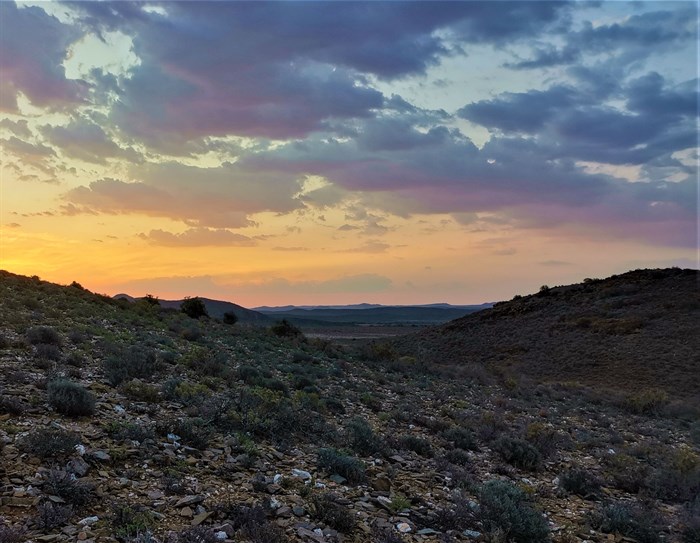
Top stories


Logistics & TransportIata urges global safeguards for aircraft systems as 5G/6G rollout continues
15 hours

AgricultureAgricultural exports from Africa are not doing well. Four ways to change that
Lilac Nachum 16 hours


The Explorer Camp
The Explorer Camp operates during summer and is set up in the most remote corner of the reserve. Situated along a shaded dry riverbed, the camp consists of three spacious tents, a fabulous hot water shower created within a Schotia Tree, and a distance away, a loo with a view, shaded by a tree and screened by a wooden lattice fence.
A fire pit, a Bedouin Tent for relaxation, and a spacious dining tent are close to the camp entrance, and the staff tents are located close to this area. This is home for the next two nights.
Game drives provide extraordinary sightings, but the walking safaris offer something quite different. It is the ultimate earth connection, and the only way to understand the allure of the Karoo. This vast, arid landscape will test, inspire and overwhelm you. Then it will intrigue and seduce you, its wild beauty is all-consuming.
We walk in silence, single file, eyes squinting against the glare of the millions of white pebbles scattered across the Quartz Field. An armed guide leads us, and another brings up the rear. The air is dry and hot, from the sun burning brightly overhead and the heat rising off the baked earth.

We stop and crouch down to inspect the dwarf succulents that inhabit this inhospitable terrain. From the Gibbaeum family, these plants have adapted to the climate and will all but disappear underground during times of drought. They grow in cracks and crevasses between rocks and only a close-up inspection reveals their beauty, and reason for the comical common names.
Haaibekkies – shark mouths, baba boudtjies – baby bums. The Crassula- Khaki Button, takes at least five years to mature, flowers once and dies. In an area that receives under 300mm of rain a year, each of these plants is a miracle, and the white, pale yellow, bright pink and rich purple flowers add vibrant colour to the landscape every spring.
Late afternoon, still hot, we are in a totally different landscape. Heading up a small Koppie on a narrow path, we navigate around shale rocks and colourful scrubby fynbos to a few meters from a thorn tree. Dozing in the scant shade is a magnificent cheetah. She raises her head, pants a bit as she looks at us, then drops her head to go back to sleep. During the walk back in the rapidly cooling air, the sky stole the show. Dramatic clouds and an endless sky mimicked the colours of the earth, from intense oranges fading to soft pinks and purples. Absolutely breathtaking.
It’s early morning and we are walking along a dry riverbed following the spoor of a rhino. We go through thickets, down sandy embankments and around fallen trees before the tracks disappear.
We pass another cheetah snoozing in the shade, and we stop to examine birds’ nests, tiny beetles, spiders and the burrows of the countless small creatures that stay close to the source of water. Finally, we join a gravel track, and a short uphill walk brings us to a boma overlooking the plains, and breakfast.
Nothing is guaranteed on a game drive, but there is always plenty to see and learn. We had many elephant sightings and spent about an hour slowly following a large herd as they crashed through thickets, kicked up dust on the road in front of us, stopped to graze and finally wandered out of view after a drink and a wash at the waterhole. Sanbona is home to the largest free-roaming herd of elephants in the Western Cape.
Further along, in a dry riverbed, we encountered three giraffes taking their time choosing juicy leaves from the trees lining the watercourse. We watched for a while and then to our delight, they regrouped in a line on a slight slope and appeared to pose for our frantically clicking cameras.
We were enchanted by a rhino with her calf wallowing in a pool and dazzled by zebra locking horns and mock fighting, all the while keeping an eye on us.

Sanbona consists of 58,000 hectares of fynbos and the succulent Karoo bisected by the Warmwaterberg mountains where ancient rock art offers a glimpse into life 3,500 years ago.
The big five roam this semi-desert, but just as fascinating are the cheetah, zebra, honey badgers, aardwolf, bat eared fox, caracul, and wide variety of antelope. If you are lucky you might catch sight of the rare white lions. Although not indigenous to the Karoo, in 2005 they were donated from trophy hunting, and captive breeding facilities. After an intense program to rewild and introduce them to the tawny lions, they now roam freely at Sanbona.
Sanbona is a leader in research and conservation of both wildlife and the natural vegetation.
The Explorer Camp only operates during summer from October to April.
No one under 16 years of age is permitted to the Explorer Camp, and anyone over 60 is requested to contact Sanbona before booking as restrictions apply.
Each tent is equipped with two comfortable stretcher beds, soft duvets and quality linen, storage space and a chemical toilet and canvas basin for nighttime use.
All meals are of a remarkably high standard, prepared on site by the staff.
Sanbona will be incrementally re-opening to welcome guests back from 1 October 2020. Sanbona has implemented measures in consultation with medical professionals to address all concerns travellers may have surrounding Covid-19.
